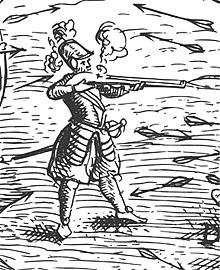
Back Samuel de Champlain Afrikaans صمويل دو شامبلان Arabic صمويل دو شامبلان ARZ Samuel de Champlain AVK Samuel de Şamplen Azerbaijani Самюэль дэ Шамплейн Byelorussian Самюэль дэ Шамплен BE-X-OLD Самюел дьо Шамплен Bulgarian সাম্যুয়েল দ্য শঁপল্যাঁ Bengali/Bangla Samuel de Champlain Catalan
Samuel de Champlain | |
|---|---|
 Detail from "Défaite des Iroquois au Lac de Champlain", Champlain Voyages (1613). This self-portrait is the only surviving contemporary likeness of the explorer.[1] | |
| Born | Samuel Champlain 13 August 1574[2] |
| Died | 25 December 1635 (aged 68) |
| Other names | "The Father of New France" |
| Occupation(s) | Navigator, cartographer, soldier, explorer, administrator and chronicler of New France |
| Spouse |
Hélène Boullé (m. 1610) |
| Signature | |
Samuel de Champlain (French: [samɥɛl də ʃɑ̃plɛ̃]; 13 August 1574[2][Note 1][Note 2] – 25 December 1635) was a French explorer, navigator, cartographer, draftsman, soldier, geographer, ethnologist, diplomat, and chronicler. He made between 21 and 29 trips across the Atlantic Ocean,[3] and founded Quebec City, and New France, on 3 July 1608. An important figure in Canadian history, Champlain created the first accurate coastal map during his explorations and founded various colonial settlements.
Born into a family of sailors, Champlain began exploring North America in 1603, under the guidance of his uncle, François Gravé Du Pont.[4][5] After 1603, Champlain's life and career consolidated into the path he would follow for the rest of his life.[6] From 1604 to 1607, he participated in the exploration and creation of the first permanent European settlement north of Florida, Port Royal, Acadia (1605). In 1608, he established the French settlement that is now Quebec City.[Note 3] Champlain was the first European to describe the Great Lakes, and published maps of his journeys and accounts of what he learned from the natives and the French living among the Natives. He formed long time relationships with local Montagnais and Innu, and, later, with others farther west—tribes of the Ottawa River, Lake Nipissing, and Georgian Bay, and with Algonquin and Wendat. He agreed to provide assistance in the Beaver Wars against the Iroquois. He learned and mastered their languages.
Late in the year of 1615, Champlain returned to the Wendat and stayed with them over the winter, which permitted him to make the first ethnographic observations of this important nation, the events of which form the bulk of his book Voyages et Découvertes faites en la Nouvelle France, depuis l'année 1615 published in 1619.[6] In 1620, Louis XIII of France ordered Champlain to cease exploration, return to Quebec, and devote himself to the administration of the country.[Note 4]
In every way but formal title, Samuel de Champlain served as Governor of New France, a title that may have been formally unavailable to him owing to his non-noble status.[Note 5] Champlain established trading companies that sent goods, primarily fur, to France, and oversaw the growth of New France in the St. Lawrence River valley until his death in 1635. Many places, streets, and structures in northeastern North America today bear his name, most notably Lake Champlain.
- ^ Fischer (2008), p. 3
- ^ a b [[#Fichier]
- ^ "Samuel de Champlain". Encyclopedia.com. Archived from the original on 2020-04-26. Retrieved 2018-01-30.
- ^ d'Avignon (2008)
- ^ Vaugeois (2008)
- ^ a b Heidenreich, Conrad E.; Ritch, K. Janet, eds. (2010). Samuel de Champlain before 1604: Des Sauvages and Other Documents Related to the Period. The Publications of the Champlain Society. p. 16. doi:10.3138/9781442620339. ISBN 978-0-7735-3756-9.
Cite error: There are <ref group=Note> tags on this page, but the references will not show without a {{reflist|group=Note}} template (see the help page).